Sheng Siong Purchasing Management: Evaluation and Recommendations
VerifiedAdded on 2020/04/07
|15
|2926
|1258
Report
AI Summary
This report provides a comprehensive analysis of Sheng Siong's purchasing management practices. It begins with an overview of the company and its competitive landscape, highlighting its use of house brands and HACCP certifications. The report then delves into Sheng Siong's supplier selection process, including background checks, product specifications, and payment terms. It explores the use of the 10Cs model for vendor evaluation and recommends the implementation of ERP systems like SAP Business One and EDI for improved efficiency. The report also discusses the application of Total Quality Management (TQM) and Total Cost Ownership (TCO) for optimizing purchasing costs and supply chain performance. The report concludes by emphasizing the importance of effective supply chain management for enhancing business performance and providing recommendations for future improvements, including the adoption of ICT software and employee training to streamline operations and maintain a competitive edge in the market.
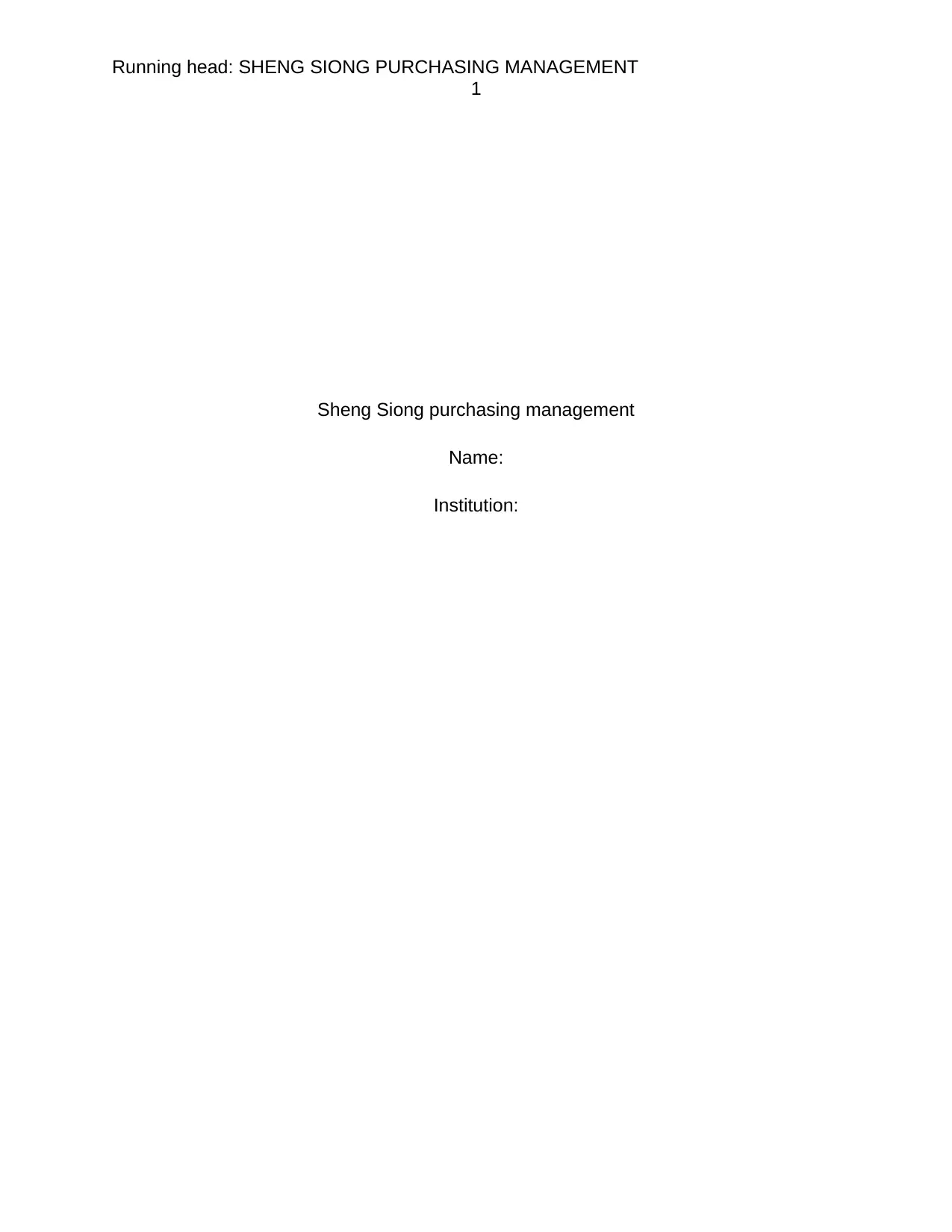
Running head: SHENG SIONG PURCHASING MANAGEMENT
1
Sheng Siong purchasing management
Name:
Institution:
1
Sheng Siong purchasing management
Name:
Institution:
Paraphrase This Document
Need a fresh take? Get an instant paraphrase of this document with our AI Paraphraser

SHENG SIONG PURCHASING MANAGEMENT 2
Introduction
Sheng Siong group is one of the largest retailers in Singapore with 37 grocery
stores across the island. The chain stores provide ranges of the fresh and chilled
produce including meat, seafood, and vegetables to processed, frozen, packaged and
preserved producers. Additionally, the supermarket offers general merchandise such as
household and toiletries products (Hooi, 2013). For the past seven years, the company
has been developing house brands to give its users best alternative to national brands
at affordable price. On March 2013, the company got HACCP certification for
processing of seafood, vegetables, and fish; from receiving of the raw materials,
storage, processing, packing and packaging of the products. Similarly, there is HACCP
certification in the repackaging of the frozen food, dried food, and fruit (YIhaN, 2012).
Established in 1985 and being listed in the August 2011, reputation and long history for
excellent and quality product at competitive prices has led to Sheng Siong to become
the best-established brand name in Singapore.
Companies such as Tesco and NTUC fair price are the main competitors of the
Sheng Siong. The Sheng Siong can get supplies locally, but the company focuses on
the neighboring countries around Asian countries and direct suppliers in China. They
can control the time delivery and higher price due to the elimination of the middlemen.
Sheng Siong’s construction and expansion of the new storage in the Mandai link will
establish a centralized distribution to increase their sustainability and scope.
Sheng Siong supermarket has commenced using secure cash–management
system from the glory global solution-UK (Adekola & Sergi, 2016). It comes as result of
solving the workforce difficulties, and it is in use across all the sheng stores in
Singapore. The system reduces the time it takes to do cash reconciliation tasks
(Schniederjans, Cao, & Triche, 2013). Additionally, it improves security and systems,
accept, authenticate and dispense cash for the users. As the CEO Lim Hock of Sheng
says that the group is the first company to implement self-payment kiosk in Singapore
(Cao & Zhang, 2011).
Introduction
Sheng Siong group is one of the largest retailers in Singapore with 37 grocery
stores across the island. The chain stores provide ranges of the fresh and chilled
produce including meat, seafood, and vegetables to processed, frozen, packaged and
preserved producers. Additionally, the supermarket offers general merchandise such as
household and toiletries products (Hooi, 2013). For the past seven years, the company
has been developing house brands to give its users best alternative to national brands
at affordable price. On March 2013, the company got HACCP certification for
processing of seafood, vegetables, and fish; from receiving of the raw materials,
storage, processing, packing and packaging of the products. Similarly, there is HACCP
certification in the repackaging of the frozen food, dried food, and fruit (YIhaN, 2012).
Established in 1985 and being listed in the August 2011, reputation and long history for
excellent and quality product at competitive prices has led to Sheng Siong to become
the best-established brand name in Singapore.
Companies such as Tesco and NTUC fair price are the main competitors of the
Sheng Siong. The Sheng Siong can get supplies locally, but the company focuses on
the neighboring countries around Asian countries and direct suppliers in China. They
can control the time delivery and higher price due to the elimination of the middlemen.
Sheng Siong’s construction and expansion of the new storage in the Mandai link will
establish a centralized distribution to increase their sustainability and scope.
Sheng Siong supermarket has commenced using secure cash–management
system from the glory global solution-UK (Adekola & Sergi, 2016). It comes as result of
solving the workforce difficulties, and it is in use across all the sheng stores in
Singapore. The system reduces the time it takes to do cash reconciliation tasks
(Schniederjans, Cao, & Triche, 2013). Additionally, it improves security and systems,
accept, authenticate and dispense cash for the users. As the CEO Lim Hock of Sheng
says that the group is the first company to implement self-payment kiosk in Singapore
(Cao & Zhang, 2011).
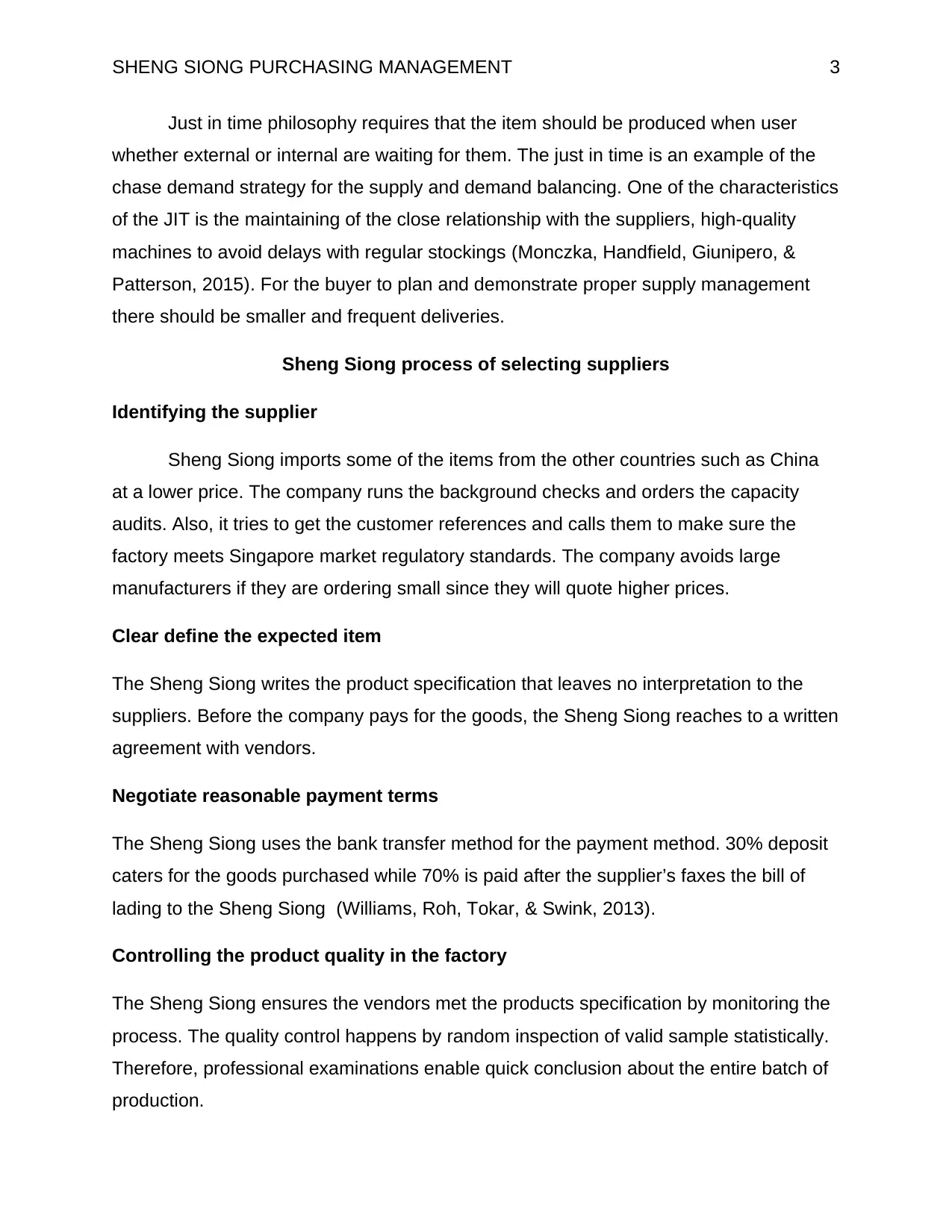
SHENG SIONG PURCHASING MANAGEMENT 3
Just in time philosophy requires that the item should be produced when user
whether external or internal are waiting for them. The just in time is an example of the
chase demand strategy for the supply and demand balancing. One of the characteristics
of the JIT is the maintaining of the close relationship with the suppliers, high-quality
machines to avoid delays with regular stockings (Monczka, Handfield, Giunipero, &
Patterson, 2015). For the buyer to plan and demonstrate proper supply management
there should be smaller and frequent deliveries.
Sheng Siong process of selecting suppliers
Identifying the supplier
Sheng Siong imports some of the items from the other countries such as China
at a lower price. The company runs the background checks and orders the capacity
audits. Also, it tries to get the customer references and calls them to make sure the
factory meets Singapore market regulatory standards. The company avoids large
manufacturers if they are ordering small since they will quote higher prices.
Clear define the expected item
The Sheng Siong writes the product specification that leaves no interpretation to the
suppliers. Before the company pays for the goods, the Sheng Siong reaches to a written
agreement with vendors.
Negotiate reasonable payment terms
The Sheng Siong uses the bank transfer method for the payment method. 30% deposit
caters for the goods purchased while 70% is paid after the supplier’s faxes the bill of
lading to the Sheng Siong (Williams, Roh, Tokar, & Swink, 2013).
Controlling the product quality in the factory
The Sheng Siong ensures the vendors met the products specification by monitoring the
process. The quality control happens by random inspection of valid sample statistically.
Therefore, professional examinations enable quick conclusion about the entire batch of
production.
Just in time philosophy requires that the item should be produced when user
whether external or internal are waiting for them. The just in time is an example of the
chase demand strategy for the supply and demand balancing. One of the characteristics
of the JIT is the maintaining of the close relationship with the suppliers, high-quality
machines to avoid delays with regular stockings (Monczka, Handfield, Giunipero, &
Patterson, 2015). For the buyer to plan and demonstrate proper supply management
there should be smaller and frequent deliveries.
Sheng Siong process of selecting suppliers
Identifying the supplier
Sheng Siong imports some of the items from the other countries such as China
at a lower price. The company runs the background checks and orders the capacity
audits. Also, it tries to get the customer references and calls them to make sure the
factory meets Singapore market regulatory standards. The company avoids large
manufacturers if they are ordering small since they will quote higher prices.
Clear define the expected item
The Sheng Siong writes the product specification that leaves no interpretation to the
suppliers. Before the company pays for the goods, the Sheng Siong reaches to a written
agreement with vendors.
Negotiate reasonable payment terms
The Sheng Siong uses the bank transfer method for the payment method. 30% deposit
caters for the goods purchased while 70% is paid after the supplier’s faxes the bill of
lading to the Sheng Siong (Williams, Roh, Tokar, & Swink, 2013).
Controlling the product quality in the factory
The Sheng Siong ensures the vendors met the products specification by monitoring the
process. The quality control happens by random inspection of valid sample statistically.
Therefore, professional examinations enable quick conclusion about the entire batch of
production.
⊘ This is a preview!⊘
Do you want full access?
Subscribe today to unlock all pages.

Trusted by 1+ million students worldwide
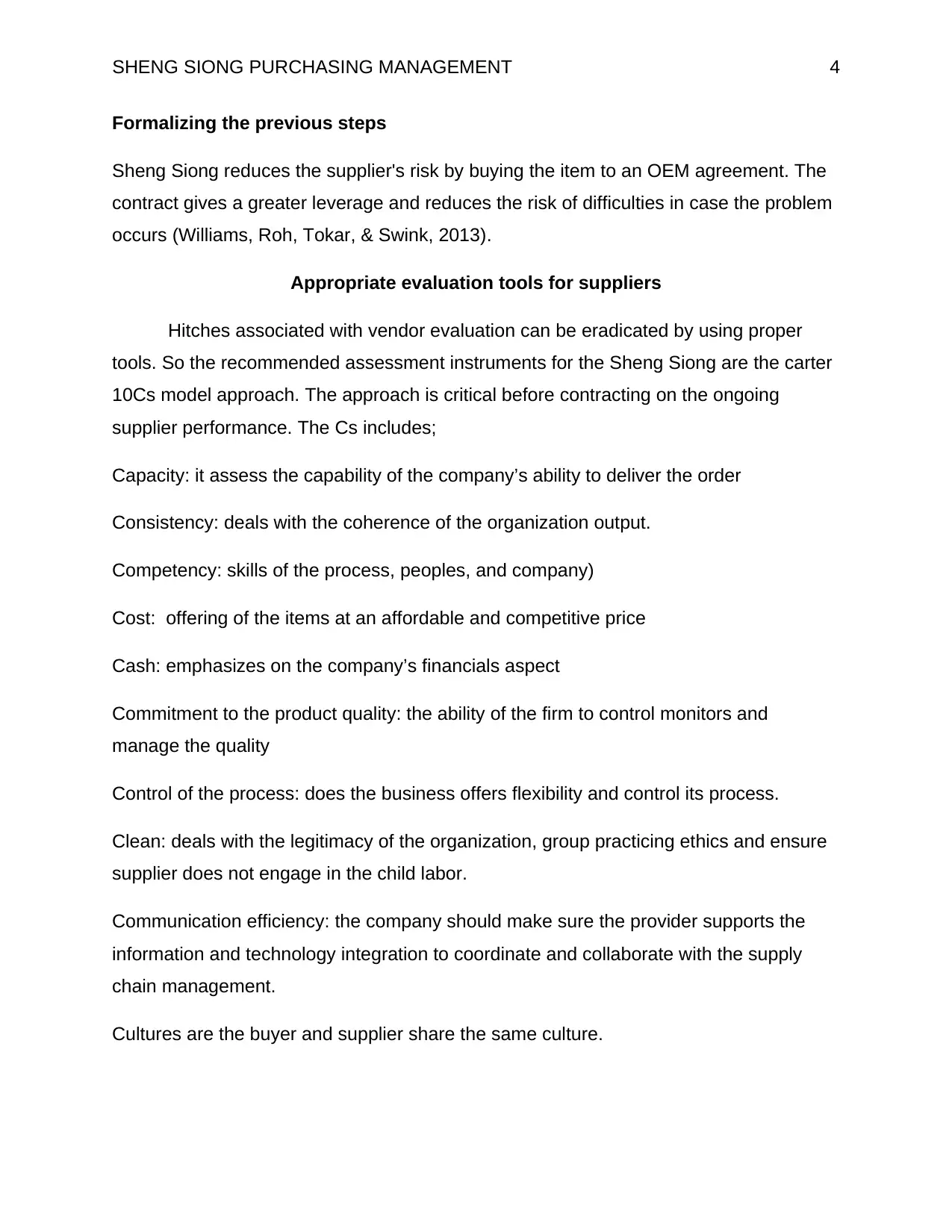
SHENG SIONG PURCHASING MANAGEMENT 4
Formalizing the previous steps
Sheng Siong reduces the supplier's risk by buying the item to an OEM agreement. The
contract gives a greater leverage and reduces the risk of difficulties in case the problem
occurs (Williams, Roh, Tokar, & Swink, 2013).
Appropriate evaluation tools for suppliers
Hitches associated with vendor evaluation can be eradicated by using proper
tools. So the recommended assessment instruments for the Sheng Siong are the carter
10Cs model approach. The approach is critical before contracting on the ongoing
supplier performance. The Cs includes;
Capacity: it assess the capability of the company’s ability to deliver the order
Consistency: deals with the coherence of the organization output.
Competency: skills of the process, peoples, and company)
Cost: offering of the items at an affordable and competitive price
Cash: emphasizes on the company’s financials aspect
Commitment to the product quality: the ability of the firm to control monitors and
manage the quality
Control of the process: does the business offers flexibility and control its process.
Clean: deals with the legitimacy of the organization, group practicing ethics and ensure
supplier does not engage in the child labor.
Communication efficiency: the company should make sure the provider supports the
information and technology integration to coordinate and collaborate with the supply
chain management.
Cultures are the buyer and supplier share the same culture.
Formalizing the previous steps
Sheng Siong reduces the supplier's risk by buying the item to an OEM agreement. The
contract gives a greater leverage and reduces the risk of difficulties in case the problem
occurs (Williams, Roh, Tokar, & Swink, 2013).
Appropriate evaluation tools for suppliers
Hitches associated with vendor evaluation can be eradicated by using proper
tools. So the recommended assessment instruments for the Sheng Siong are the carter
10Cs model approach. The approach is critical before contracting on the ongoing
supplier performance. The Cs includes;
Capacity: it assess the capability of the company’s ability to deliver the order
Consistency: deals with the coherence of the organization output.
Competency: skills of the process, peoples, and company)
Cost: offering of the items at an affordable and competitive price
Cash: emphasizes on the company’s financials aspect
Commitment to the product quality: the ability of the firm to control monitors and
manage the quality
Control of the process: does the business offers flexibility and control its process.
Clean: deals with the legitimacy of the organization, group practicing ethics and ensure
supplier does not engage in the child labor.
Communication efficiency: the company should make sure the provider supports the
information and technology integration to coordinate and collaborate with the supply
chain management.
Cultures are the buyer and supplier share the same culture.
Paraphrase This Document
Need a fresh take? Get an instant paraphrase of this document with our AI Paraphraser
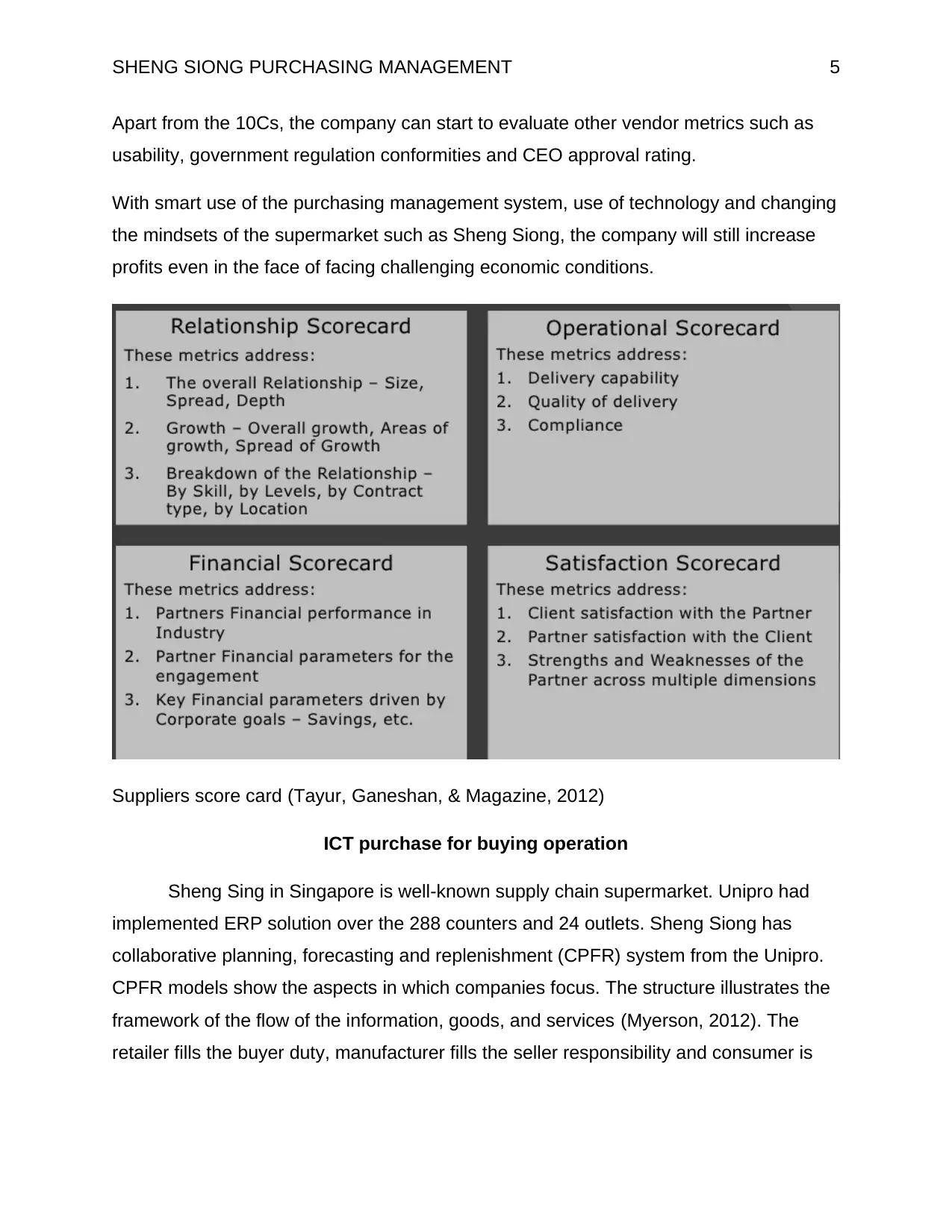
SHENG SIONG PURCHASING MANAGEMENT 5
Apart from the 10Cs, the company can start to evaluate other vendor metrics such as
usability, government regulation conformities and CEO approval rating.
With smart use of the purchasing management system, use of technology and changing
the mindsets of the supermarket such as Sheng Siong, the company will still increase
profits even in the face of facing challenging economic conditions.
Suppliers score card (Tayur, Ganeshan, & Magazine, 2012)
ICT purchase for buying operation
Sheng Sing in Singapore is well-known supply chain supermarket. Unipro had
implemented ERP solution over the 288 counters and 24 outlets. Sheng Siong has
collaborative planning, forecasting and replenishment (CPFR) system from the Unipro.
CPFR models show the aspects in which companies focus. The structure illustrates the
framework of the flow of the information, goods, and services (Myerson, 2012). The
retailer fills the buyer duty, manufacturer fills the seller responsibility and consumer is
Apart from the 10Cs, the company can start to evaluate other vendor metrics such as
usability, government regulation conformities and CEO approval rating.
With smart use of the purchasing management system, use of technology and changing
the mindsets of the supermarket such as Sheng Siong, the company will still increase
profits even in the face of facing challenging economic conditions.
Suppliers score card (Tayur, Ganeshan, & Magazine, 2012)
ICT purchase for buying operation
Sheng Sing in Singapore is well-known supply chain supermarket. Unipro had
implemented ERP solution over the 288 counters and 24 outlets. Sheng Siong has
collaborative planning, forecasting and replenishment (CPFR) system from the Unipro.
CPFR models show the aspects in which companies focus. The structure illustrates the
framework of the flow of the information, goods, and services (Myerson, 2012). The
retailer fills the buyer duty, manufacturer fills the seller responsibility and consumer is
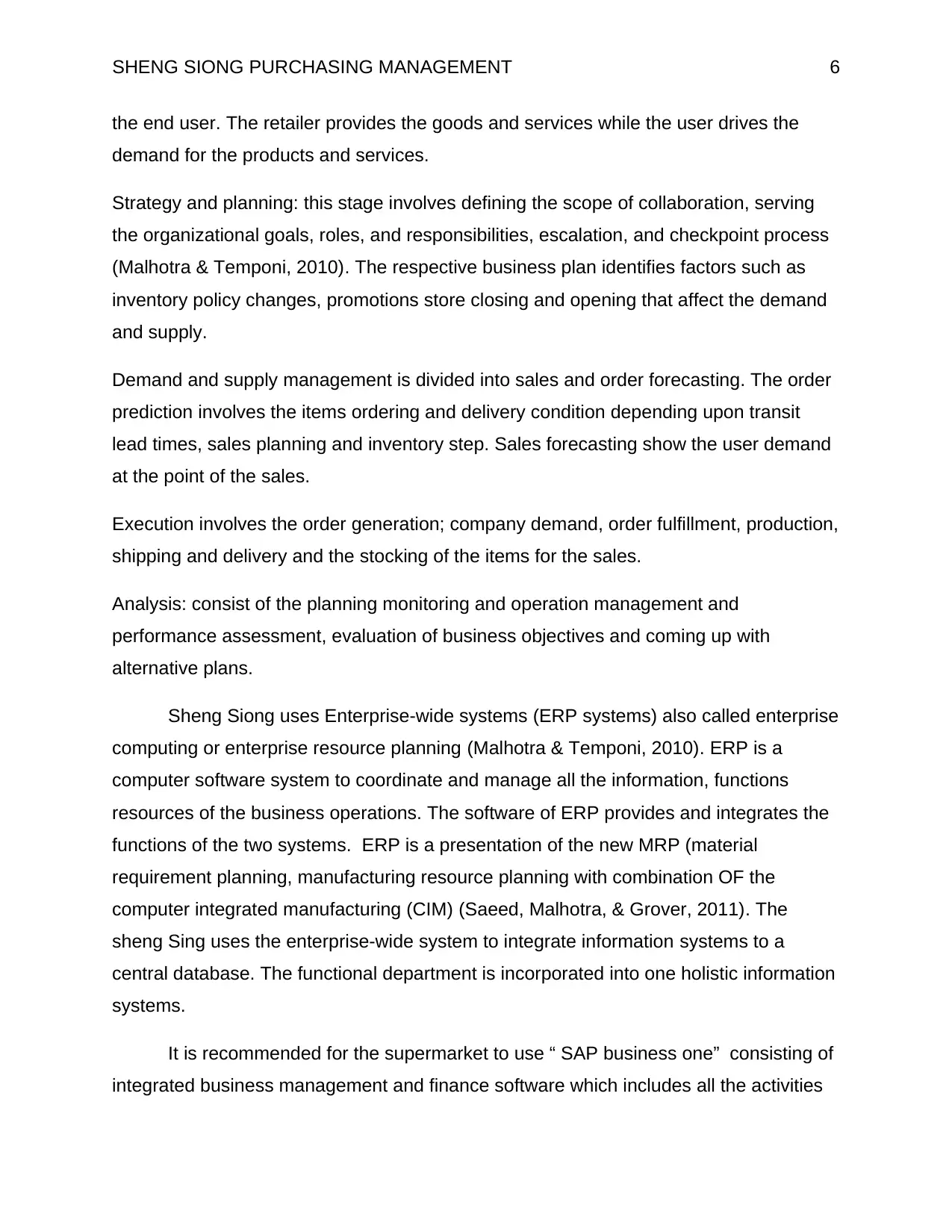
SHENG SIONG PURCHASING MANAGEMENT 6
the end user. The retailer provides the goods and services while the user drives the
demand for the products and services.
Strategy and planning: this stage involves defining the scope of collaboration, serving
the organizational goals, roles, and responsibilities, escalation, and checkpoint process
(Malhotra & Temponi, 2010). The respective business plan identifies factors such as
inventory policy changes, promotions store closing and opening that affect the demand
and supply.
Demand and supply management is divided into sales and order forecasting. The order
prediction involves the items ordering and delivery condition depending upon transit
lead times, sales planning and inventory step. Sales forecasting show the user demand
at the point of the sales.
Execution involves the order generation; company demand, order fulfillment, production,
shipping and delivery and the stocking of the items for the sales.
Analysis: consist of the planning monitoring and operation management and
performance assessment, evaluation of business objectives and coming up with
alternative plans.
Sheng Siong uses Enterprise-wide systems (ERP systems) also called enterprise
computing or enterprise resource planning (Malhotra & Temponi, 2010). ERP is a
computer software system to coordinate and manage all the information, functions
resources of the business operations. The software of ERP provides and integrates the
functions of the two systems. ERP is a presentation of the new MRP (material
requirement planning, manufacturing resource planning with combination OF the
computer integrated manufacturing (CIM) (Saeed, Malhotra, & Grover, 2011). The
sheng Sing uses the enterprise-wide system to integrate information systems to a
central database. The functional department is incorporated into one holistic information
systems.
It is recommended for the supermarket to use “ SAP business one” consisting of
integrated business management and finance software which includes all the activities
the end user. The retailer provides the goods and services while the user drives the
demand for the products and services.
Strategy and planning: this stage involves defining the scope of collaboration, serving
the organizational goals, roles, and responsibilities, escalation, and checkpoint process
(Malhotra & Temponi, 2010). The respective business plan identifies factors such as
inventory policy changes, promotions store closing and opening that affect the demand
and supply.
Demand and supply management is divided into sales and order forecasting. The order
prediction involves the items ordering and delivery condition depending upon transit
lead times, sales planning and inventory step. Sales forecasting show the user demand
at the point of the sales.
Execution involves the order generation; company demand, order fulfillment, production,
shipping and delivery and the stocking of the items for the sales.
Analysis: consist of the planning monitoring and operation management and
performance assessment, evaluation of business objectives and coming up with
alternative plans.
Sheng Siong uses Enterprise-wide systems (ERP systems) also called enterprise
computing or enterprise resource planning (Malhotra & Temponi, 2010). ERP is a
computer software system to coordinate and manage all the information, functions
resources of the business operations. The software of ERP provides and integrates the
functions of the two systems. ERP is a presentation of the new MRP (material
requirement planning, manufacturing resource planning with combination OF the
computer integrated manufacturing (CIM) (Saeed, Malhotra, & Grover, 2011). The
sheng Sing uses the enterprise-wide system to integrate information systems to a
central database. The functional department is incorporated into one holistic information
systems.
It is recommended for the supermarket to use “ SAP business one” consisting of
integrated business management and finance software which includes all the activities
⊘ This is a preview!⊘
Do you want full access?
Subscribe today to unlock all pages.

Trusted by 1+ million students worldwide

SHENG SIONG PURCHASING MANAGEMENT 7
one require to manage a business, for instance, inventory, banking, financials,
production service, human resource and customer relationship management.
SAP business one (Chen, Chiang, & Storey, 2012).
Benefits of the ERP systems include integration of the suppliers to speed the
lead times to improve the quality of the supply chain management. Integration of the
ERP software application can help to fasten the reporting (Chen, Chiang, & Storey,
2012). The systems give the real-time data captures along reporting the results of the
finances. Finally, the systems represent the data for the all the levels of the
management. One of the limitations of ERP consists of expensive to develop and
maintain, high switching costs, ERP systems industry standard prescriptions may not
gain a competitive edge (Monk & Wagner, 2012). There is a risk of losing information
due to database approach. Lastly, there is an inadequate investment in training the
users.
Similarly, the supermarket can use the Electronic data interchange (EDI). EDI is
a computer to computer interchange for the electronic billing and invoicing and payment
of the transactions between the firms and its suppliers through the use of the extranet
one require to manage a business, for instance, inventory, banking, financials,
production service, human resource and customer relationship management.
SAP business one (Chen, Chiang, & Storey, 2012).
Benefits of the ERP systems include integration of the suppliers to speed the
lead times to improve the quality of the supply chain management. Integration of the
ERP software application can help to fasten the reporting (Chen, Chiang, & Storey,
2012). The systems give the real-time data captures along reporting the results of the
finances. Finally, the systems represent the data for the all the levels of the
management. One of the limitations of ERP consists of expensive to develop and
maintain, high switching costs, ERP systems industry standard prescriptions may not
gain a competitive edge (Monk & Wagner, 2012). There is a risk of losing information
due to database approach. Lastly, there is an inadequate investment in training the
users.
Similarly, the supermarket can use the Electronic data interchange (EDI). EDI is
a computer to computer interchange for the electronic billing and invoicing and payment
of the transactions between the firms and its suppliers through the use of the extranet
Paraphrase This Document
Need a fresh take? Get an instant paraphrase of this document with our AI Paraphraser
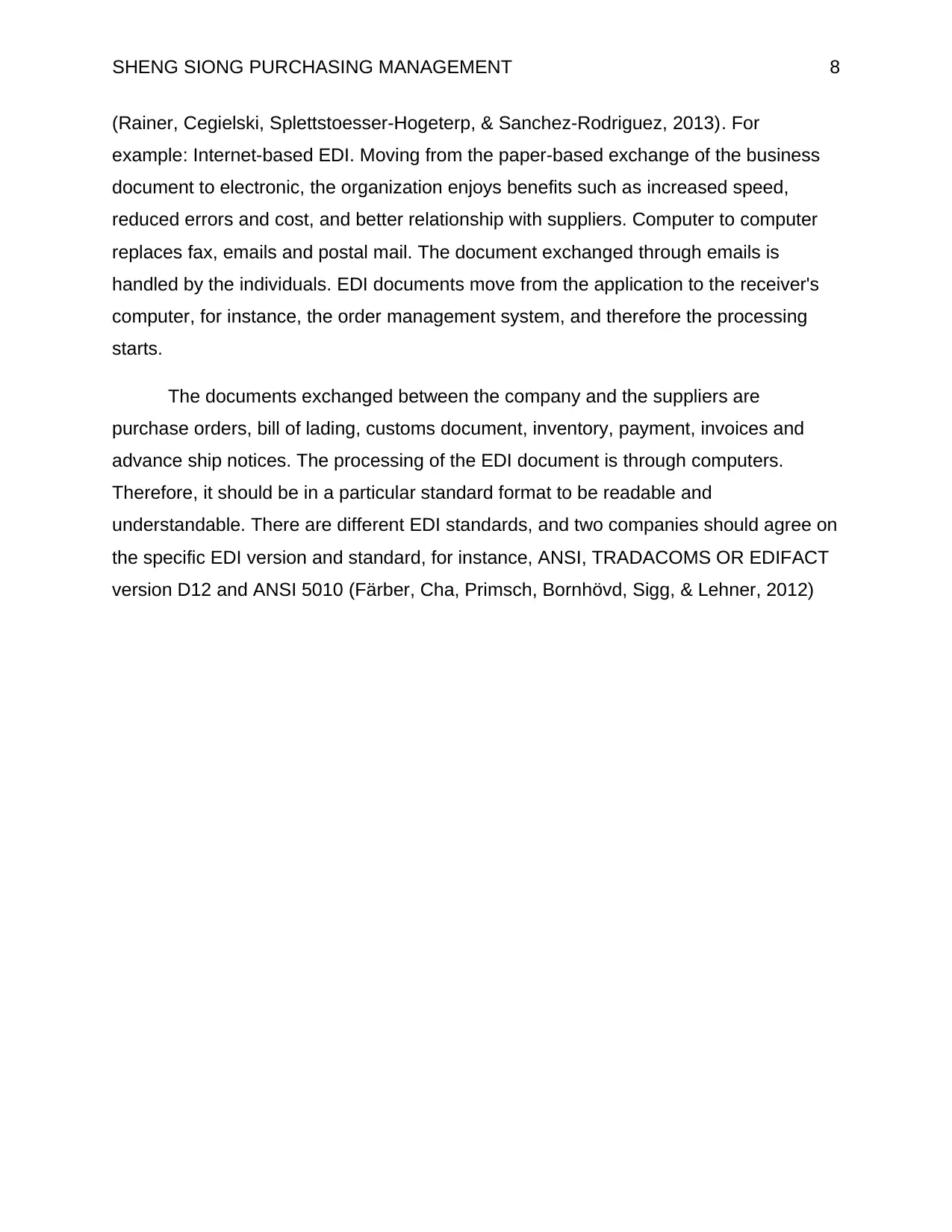
SHENG SIONG PURCHASING MANAGEMENT 8
(Rainer, Cegielski, Splettstoesser-Hogeterp, & Sanchez-Rodriguez, 2013). For
example: Internet-based EDI. Moving from the paper-based exchange of the business
document to electronic, the organization enjoys benefits such as increased speed,
reduced errors and cost, and better relationship with suppliers. Computer to computer
replaces fax, emails and postal mail. The document exchanged through emails is
handled by the individuals. EDI documents move from the application to the receiver's
computer, for instance, the order management system, and therefore the processing
starts.
The documents exchanged between the company and the suppliers are
purchase orders, bill of lading, customs document, inventory, payment, invoices and
advance ship notices. The processing of the EDI document is through computers.
Therefore, it should be in a particular standard format to be readable and
understandable. There are different EDI standards, and two companies should agree on
the specific EDI version and standard, for instance, ANSI, TRADACOMS OR EDIFACT
version D12 and ANSI 5010 (Färber, Cha, Primsch, Bornhövd, Sigg, & Lehner, 2012)
(Rainer, Cegielski, Splettstoesser-Hogeterp, & Sanchez-Rodriguez, 2013). For
example: Internet-based EDI. Moving from the paper-based exchange of the business
document to electronic, the organization enjoys benefits such as increased speed,
reduced errors and cost, and better relationship with suppliers. Computer to computer
replaces fax, emails and postal mail. The document exchanged through emails is
handled by the individuals. EDI documents move from the application to the receiver's
computer, for instance, the order management system, and therefore the processing
starts.
The documents exchanged between the company and the suppliers are
purchase orders, bill of lading, customs document, inventory, payment, invoices and
advance ship notices. The processing of the EDI document is through computers.
Therefore, it should be in a particular standard format to be readable and
understandable. There are different EDI standards, and two companies should agree on
the specific EDI version and standard, for instance, ANSI, TRADACOMS OR EDIFACT
version D12 and ANSI 5010 (Färber, Cha, Primsch, Bornhövd, Sigg, & Lehner, 2012)
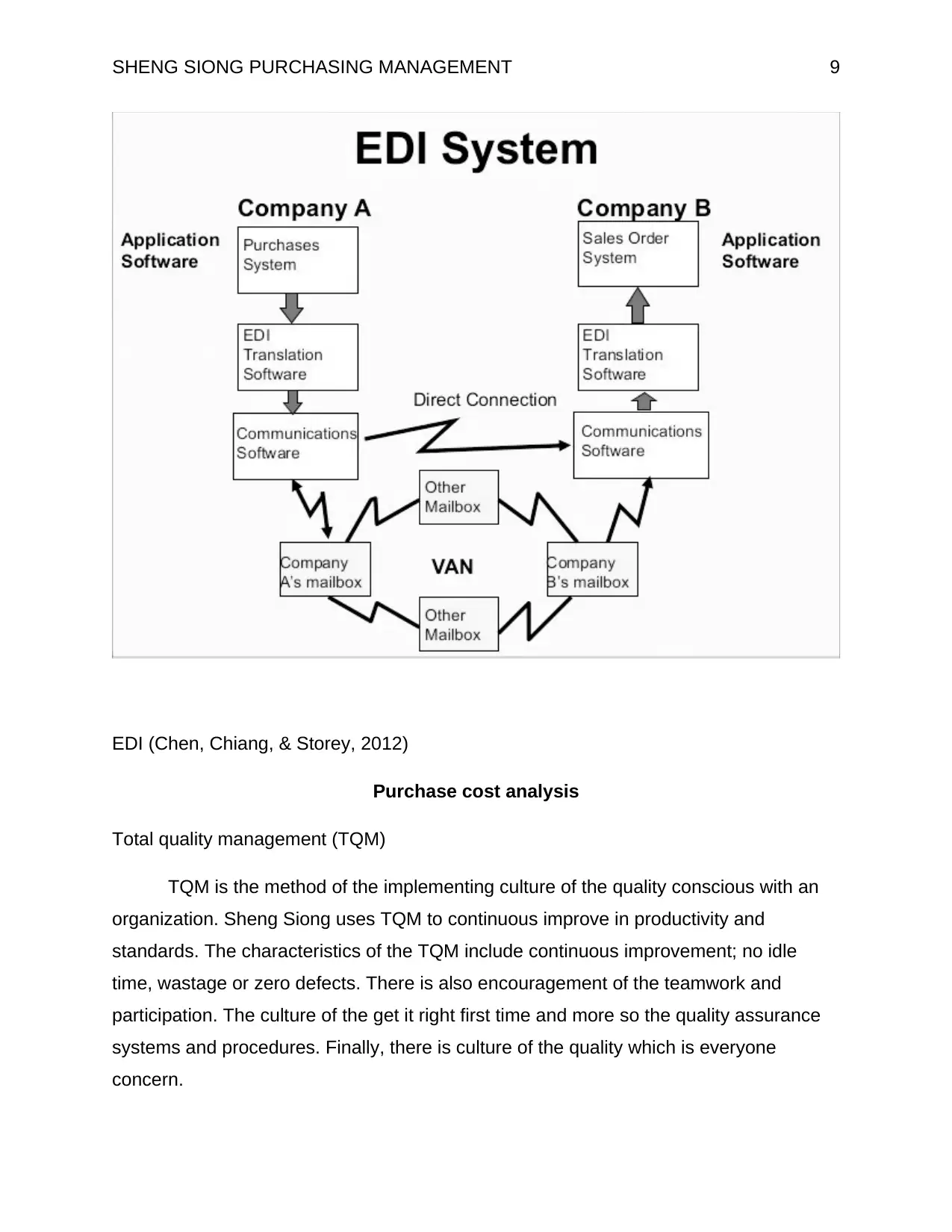
SHENG SIONG PURCHASING MANAGEMENT 9
EDI (Chen, Chiang, & Storey, 2012)
Purchase cost analysis
Total quality management (TQM)
TQM is the method of the implementing culture of the quality conscious with an
organization. Sheng Siong uses TQM to continuous improve in productivity and
standards. The characteristics of the TQM include continuous improvement; no idle
time, wastage or zero defects. There is also encouragement of the teamwork and
participation. The culture of the get it right first time and more so the quality assurance
systems and procedures. Finally, there is culture of the quality which is everyone
concern.
EDI (Chen, Chiang, & Storey, 2012)
Purchase cost analysis
Total quality management (TQM)
TQM is the method of the implementing culture of the quality conscious with an
organization. Sheng Siong uses TQM to continuous improve in productivity and
standards. The characteristics of the TQM include continuous improvement; no idle
time, wastage or zero defects. There is also encouragement of the teamwork and
participation. The culture of the get it right first time and more so the quality assurance
systems and procedures. Finally, there is culture of the quality which is everyone
concern.
⊘ This is a preview!⊘
Do you want full access?
Subscribe today to unlock all pages.

Trusted by 1+ million students worldwide
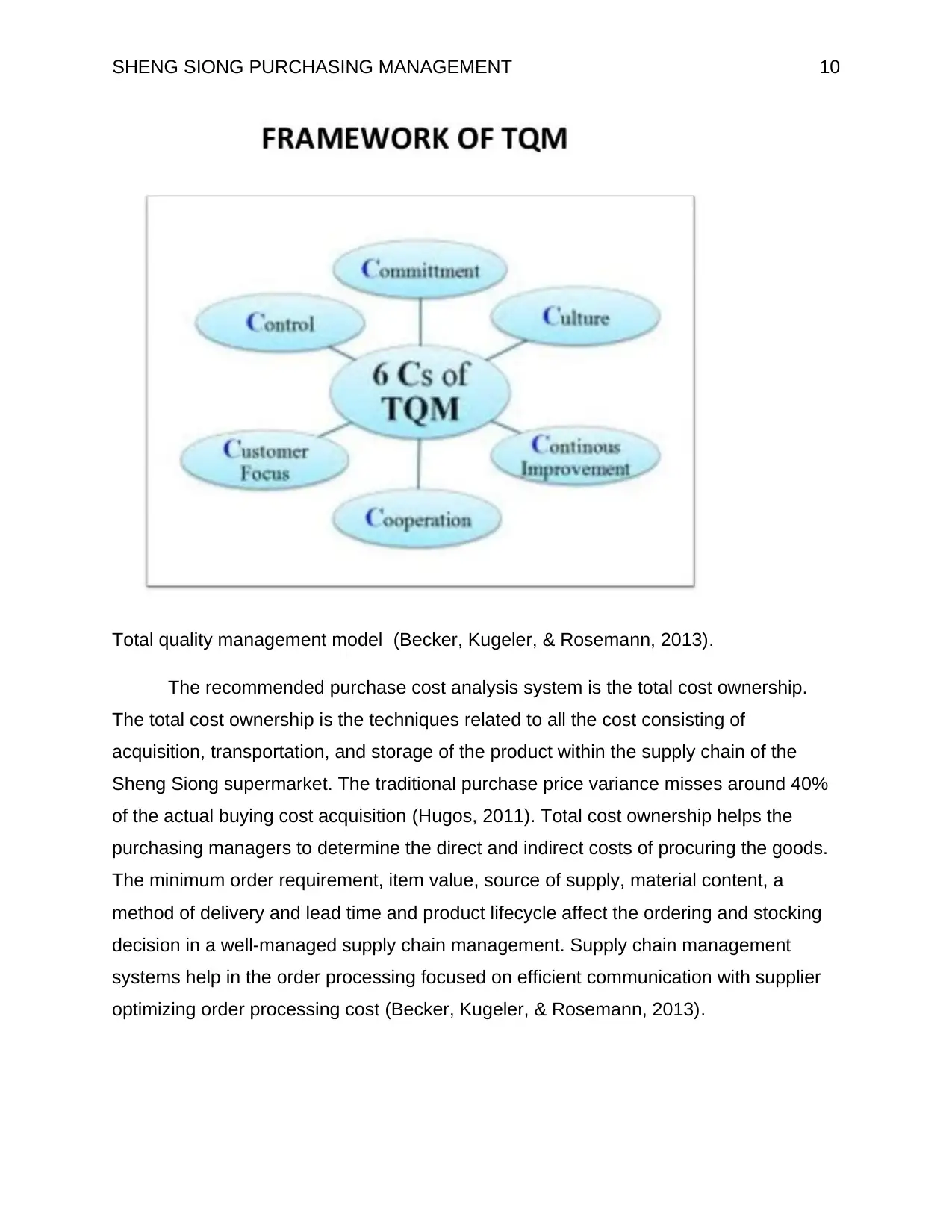
SHENG SIONG PURCHASING MANAGEMENT 10
Total quality management model (Becker, Kugeler, & Rosemann, 2013).
The recommended purchase cost analysis system is the total cost ownership.
The total cost ownership is the techniques related to all the cost consisting of
acquisition, transportation, and storage of the product within the supply chain of the
Sheng Siong supermarket. The traditional purchase price variance misses around 40%
of the actual buying cost acquisition (Hugos, 2011). Total cost ownership helps the
purchasing managers to determine the direct and indirect costs of procuring the goods.
The minimum order requirement, item value, source of supply, material content, a
method of delivery and lead time and product lifecycle affect the ordering and stocking
decision in a well-managed supply chain management. Supply chain management
systems help in the order processing focused on efficient communication with supplier
optimizing order processing cost (Becker, Kugeler, & Rosemann, 2013).
Total quality management model (Becker, Kugeler, & Rosemann, 2013).
The recommended purchase cost analysis system is the total cost ownership.
The total cost ownership is the techniques related to all the cost consisting of
acquisition, transportation, and storage of the product within the supply chain of the
Sheng Siong supermarket. The traditional purchase price variance misses around 40%
of the actual buying cost acquisition (Hugos, 2011). Total cost ownership helps the
purchasing managers to determine the direct and indirect costs of procuring the goods.
The minimum order requirement, item value, source of supply, material content, a
method of delivery and lead time and product lifecycle affect the ordering and stocking
decision in a well-managed supply chain management. Supply chain management
systems help in the order processing focused on efficient communication with supplier
optimizing order processing cost (Becker, Kugeler, & Rosemann, 2013).
Paraphrase This Document
Need a fresh take? Get an instant paraphrase of this document with our AI Paraphraser

SHENG SIONG PURCHASING MANAGEMENT 11
Total cost ownership (Becker, Kugeler, & Rosemann, 2013)
Conclusion
Apparently, it is important to implement the supply chain management effectively
to progress in the business performance. The Sheng Siong has to come up with a better
purchase system to maintain a good relationship with customers; feedback and
payment. Proper acquisition operation and management system will ensure proper
integration of all network of the supply from one person to another person network for
appropriate sharing of information. In case of the introduction of the new system in
Sheng Siong, It is important for the managers to motivate and encourage employees to
take part in the training to avoid problems. Additionally, application of proper ICT
software is crucial to replace the workforce which is time-consuming. The Sheng Siong
Total cost ownership (Becker, Kugeler, & Rosemann, 2013)
Conclusion
Apparently, it is important to implement the supply chain management effectively
to progress in the business performance. The Sheng Siong has to come up with a better
purchase system to maintain a good relationship with customers; feedback and
payment. Proper acquisition operation and management system will ensure proper
integration of all network of the supply from one person to another person network for
appropriate sharing of information. In case of the introduction of the new system in
Sheng Siong, It is important for the managers to motivate and encourage employees to
take part in the training to avoid problems. Additionally, application of proper ICT
software is crucial to replace the workforce which is time-consuming. The Sheng Siong
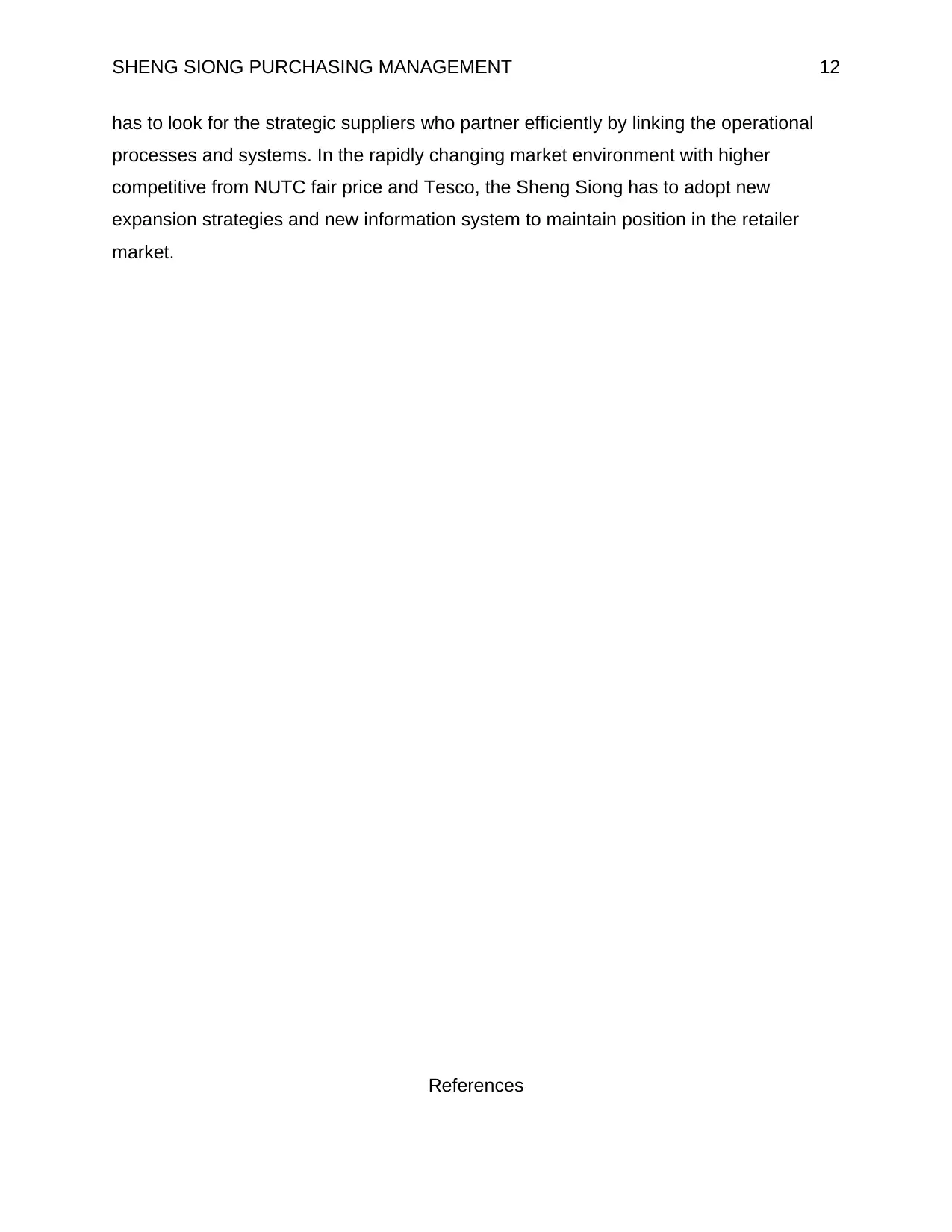
SHENG SIONG PURCHASING MANAGEMENT 12
has to look for the strategic suppliers who partner efficiently by linking the operational
processes and systems. In the rapidly changing market environment with higher
competitive from NUTC fair price and Tesco, the Sheng Siong has to adopt new
expansion strategies and new information system to maintain position in the retailer
market.
References
has to look for the strategic suppliers who partner efficiently by linking the operational
processes and systems. In the rapidly changing market environment with higher
competitive from NUTC fair price and Tesco, the Sheng Siong has to adopt new
expansion strategies and new information system to maintain position in the retailer
market.
References
⊘ This is a preview!⊘
Do you want full access?
Subscribe today to unlock all pages.

Trusted by 1+ million students worldwide
1 out of 15
Your All-in-One AI-Powered Toolkit for Academic Success.
+13062052269
info@desklib.com
Available 24*7 on WhatsApp / Email
![[object Object]](/_next/static/media/star-bottom.7253800d.svg)
Unlock your academic potential
Copyright © 2020–2025 A2Z Services. All Rights Reserved. Developed and managed by ZUCOL.


